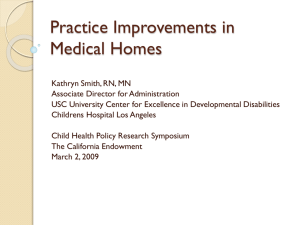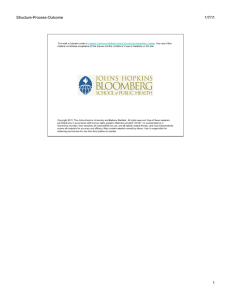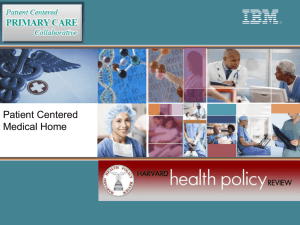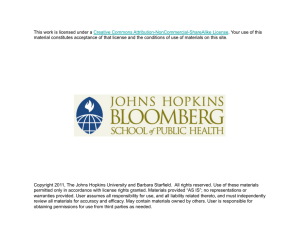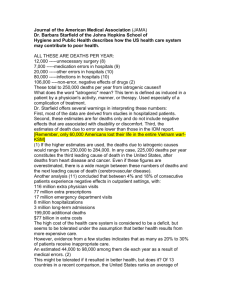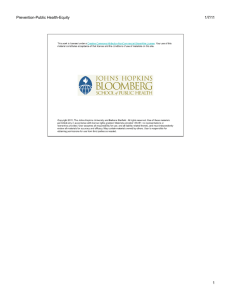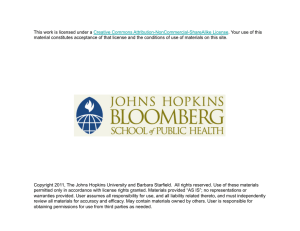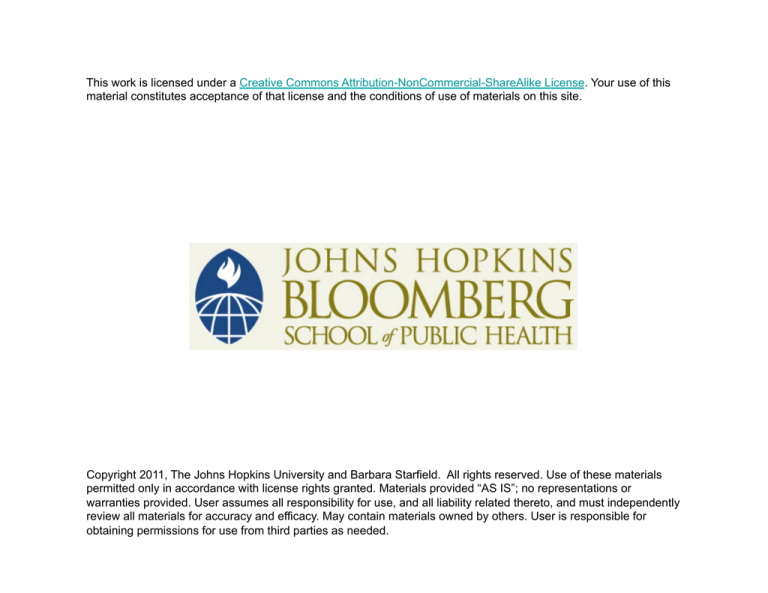
This work is licensed under a Creative Commons Attribution-NonCommercial-ShareAlike License. Your use of this
material constitutes acceptance of that license and the conditions of use of materials on this site.
Copyright 2011, The Johns Hopkins University and Barbara Starfield. All rights reserved. Use of these materials
permitted only in accordance with license rights granted. Materials provided “AS IS”; no representations or
warranties provided. User assumes all responsibility for use, and all liability related thereto, and must independently
review all materials for accuracy and efficacy. May contain materials owned by others. User is responsible for
obtaining permissions for use from third parties as needed.
Primary Care
and Public Health
Barbara Starfield, MD, MPH
Primary Care Course
(Based on Cape Town, South Africa, 2007;
and Barcelona, Spain, 2009)
This presentation presents the
difference between care of patients
(Primary Care) and the care of
populations (Public Health) The
differences are becoming blurred
over time, and the roles differ from
place to place, as shown in a study
carried out in eight different
countries.
Starfield 02/11
PCB 7462
Public Health
“Organized community efforts
aimed at the prevention of
disease and the promotion of
health”
Source: Holland & Knox. Oxford Textbook of Public Health, 2nd ed.
Vol. 1: Influences of Public Health. Oxford U. Press, 1991.
Starfield 10/02
PH 5097
Role of Public Health
1. Provide resources
2. Assess population needs
3. Develop policy for linking levels
of care
4. Assure effectiveness, efficiency,
equity
Starfield 09/97
PH 5200
Essential Public Health Functions That 30 National
Public Health Institutions View as Being Part of
Their Portfolio
Source: Binder et al, J Public Health Policy 2008;29:3-21.
Starfield 05/09
PH 7233 n
Core Functions of Public
Health, IOM 1988
Assessment of health status
Development of public health policy by
promoting the use of scientific decision-making
about public health
Assuring constituents that necessary services
are provided and involving key policy makers
in determining a set of high priority personal
and community-wide health services
Starfield 04/97
PH 5095
Core Responsibilities
PUBLIC HEALTH
• Prevent spread of disease
• Protect against environmental hazards
• Promote healthy behaviors and mental
health
• Respond to disasters
etc. (n=16, none of which involve providing
health services to individuals)
[This list is similar to WHO Delphi survey - Bettcher et al, World Health Stat Q
1998; 51(1):44-54.]
Source: Statement, Public Health Functions Steering Committee (US), 1994.
Starfield 09/01
LINK 5755
Core Responsibilities
CLINICAL MEDICINE
• Prevent disease in individuals
• Treat disease in individuals
– Cure
– Minimize disability
– Prevent progression
Starfield 10/01
LINK 5766
Public Health Usually
Assumes Responsibility for
• Non-personal health services
• Personal health services where
– populations are threatened
– clinical care has not yet adapted
to recognizing and addressing
population health needs
Starfield 07/07
PH 5762 n
Synergies between Public
and Clinical Medicine
• Services: coordinating care for individuals
• Access: establishing frameworks to provide
services for the uninsured.
• Quality: applying a population perspective to
medical practice
• Using clinical practice to identify and address
community health problems
• Mobilizing community campaigns for health
promotion/protection
• Collaborating around policy, training, and
research
Source: Lasker R, Committee on Medicine and Public Health. Medicine and Public
Health: The Power of Collaboration. New York Academy of Medicine, 1997.
Starfield 06/98
LINK 5348
Types of Interventions
Target group
A. Health protection, promotion, avoiding risk (1º)
B. Early
detection (2º)
C. Remediation (3º & 4º)
Generalized
Populations*
Individuals
Selective
Indicated
*or all people of a given age
Starfield 07/07
LINK 5350 an
Types of Interventions
A. Health protection, promotion, avoiding risk (1º)
B. Early
detection (2º)
C. Remediation (3º & 4º)
PH
PH
PH (PC)
PH/PC
PH/PC
PH/PC
Selective
?
PC/PH
PC/PH
Indicated
PC/PH
PC/PH
PC (PH)
Target group
Generalized
Populations*
Individuals
*or all people of a given age
Starfield 07/07
LINK 5349 an
Types of Interventions
Target group
Primary
Secondary
Tertiary & Quaternary
Generalized
Populations
Environmental planning Environmental
monitoring and
product control
Public advocacy
Community mobiliza-tion
(legal and social remedy)
Individuals
Health education
campaigns
Immunizations
PKU screening Information systems:
Breast cancer data standardization,
screening
collection, analysis and
dissemination
Selective
Genetic engineering
Blood lead
screening
Outreach/access, e.g.,
home visiting
Indicated
Communicable disease
control
Prophylactic antibiotics
Practice guidelines
Frequent
follow-up for
disease
recurrence
Address problems:
quality assessment of
clinical services,
including adverse events
Starfield 07/07
LINK 5351 an
Types of Interventions
Target group
A. Health protection,
promotion, avoiding
risk (1º)
B. Early detection
(2º)
C. Remediation (3º & 4º)*
Population
As population**
All individuals
Selective
Indicated
*includes remediation and/or retardation of progression as
well as avoidance of harm (quaternary prevention)
**or all people of a given age
Starfield 07/07
LINK 5350 bn
Types of Interventions
A. Health protection,
promotion, avoiding risk
(1º)
B. Early detection
(2º)
C. Remediation (3º & 4º)
As population*
PH
PH
PH (PC)
All individuals
PH/PC
PH/PC
PH/PC
Selective
?
PC/PH
PC/PH
Indicated
PC/PH
PC/PH
PC (PH)
Target group
Population
*or all people of a given age
Starfield 07/07
LINK 5349 bn
Types of Interventions
Target group
Primary
Secondary
Tertiary & Quaternary
Population
As
Environmental
population planning
Environmental
monitoring and
product control
Public advocacy
Community mobilization
(legal and social remedy)
All
Health education
individuals
campaigns
Immunizations
PKU screening
Breast cancer
screening
Information systems:
data standardization,
collection, analysis and
dissemination
Blood lead
screening
Outreach/access, e.g.,
home visiting
Selective
Genetic engineering
Indicated
Communicable
Frequent followdisease control
up for disease
Prophylactic antibiotics recurrence
Practice guidelines
Address problems:
quality assessment of
clinical services,
including adverse events
Starfield 07/07
LINK 5351 bn
Levels and Types of Interventions to
Improve Health*
Societal (population) level
Individual level
Physical
environment
Environmental planning, monitoring,
regulation
Responsible use of
environmental resources
Social
environment
Public advocacy, community mobilization
Promotion of solidarity
Health services
environment
Resource mobilization/deployment
Early recognition of problems
regardless of their genesis
Information systems: collection, analysis,
and dissemination for early identification of
problems and iatrogenesis
Personal
environment
Genetic engineering
Responsible stewardship of
one’s health
*Locus of responsibility may vary from one jurisdiction to another but must be explicit and
with accountability.
Source: Sheridan et al, Am J Prev Med 2004;26:56-66.
Starfield 10/08
PREV 7028 n
Where the risk factor is to be avoided or
managed in particularly vulnerable
individuals (e.g., those with compromised
resilience) rather than in defined population
subgroups, the responsibility lies with clinical
care.
The challenge is to decide the appropriate
locus of responsibility if the risk factor is to be
avoided or managed in the general
population or in selected subgroups of the
population.
Starfield 04/07
PREV 6721
The Reality
Starfield 09/01
LINK 5758
Survey of Locus of
Responsibility for
Selected Preventive
Services: 2001
Starfield 10/01
LINK 5772
Jurisdictions for Survey
Belgium (B)
Canada: Quebec (Q)
Norway (N)
Spain: Andalucia (A), Asturias (S), Madrid (M)
UK (U)
US: Illinois (I)
Starfield 10/01
LINK 5773 n
Hypothesis
Extent to which services directed at
individuals in populations are
carried out by public health depends
on the degree to which primary care
services are responsible for defined
populations.
Starfield 10/01
LINK 5775
Corollary
Countries such as the UK and
Denmark, with defined populations
in primary care, would be expected
to have more of these services in
the primary care sector.
Starfield 10/01
LINK 5776
Corollary
In countries where primary care
services are not directed at
populations, provision of
population-focused services
(such as immunizations) in the
primary care sector signifies
inadequate public health
services.
Starfield 10/01
LINK 5777
Interventions by Target Group
Likely target
Interventions
All individuals
(age/gender appropriate)
Influenza immunization
Childhood immunizations
PKU screening
Sociodemographically indicated
(selected subpopulations)
Breast cancer screening
Hypertension screening
TBC screening
HIV screening
Osteoporosis screening
Individually indicated
Starfield 07/07
LINK 5774
Procedures for Hypertension
Target (All=3U,M,I, Sel=2A,S, Indiv=3Q,B,N)
Govt/HA
Professional
Primary
care
Hosp
only
Variable/
none
Policy
Contact
F/U
Records
4U,A,S,M
0
0
0
3Q,I,N
0
0
0
0
6U,A,M,S,I,N
8Q,U,B,A,M,S,I,N
7U,B,A,M,S,I,N
0
0
0
0
1B
2B,Q
0
1Q
Starfield 10/01
LINK 5778 a
Procedures for Mammography
Target (All=8)
Policy
Contact
F/U
Records
Govt/HA
8
3Q,B,N
0
0
Primary
care
0
4U,M,S,I
3B,I,N
3B,M,N
Hosp only
0
1A
4U,A,M,S
3U,A,S
Variable/
none
0
0
1Q
2Q,I
Starfield 10/01
LINK 5779 a
Procedures for PKU
Target (All=8)
Policy
Contact
F/U
Records
Govt/HA
8
2B,A
0
0
Primary
care
0
3U,S,N
0
4B,M,N
0
3Q,M,I
7Q,U,B,A,M,S,N
4Q,U,A,S
0
0
1I
1I
Hosp
only
Variable/
none
Starfield 10/01
LINK 5780 a
Procedures for TBC
Target (All=1N, Sel=2Q,I, Indiv=5U,B,A,M,S)
Govt/HA
Primary
care
Hosp
only
Variable/
none
Policy
Contact
F/U
Records
7Q,U,B,S,I,N,M
1N
0
1N
0
6B,Q,U,M,S,I
4U,B,M,S
5U,B,M,S,I
1A
1A
2A,N
1A
0
0
2Q,I
1Q
Starfield 10/01
LINK 5781 a
Procedures for Flu
Target (All=7B,Q,U,A,M,S,I, Sel=0, Indiv=1N)
Govt/HA
Professional
Primary
care
Hosp
only
Variable/
none
Policy
Contact
5Q,U,M,S,A
0
3B,I,N
0
0
8B,Q,U,A,M,S,I,N
0
0
0
0
Starfield 10/01
LINK 5782 a
Procedures for HIV
Target (All=0, Sel=2Q,U, Indiv=6B,A,S,I,N,M)
Govt/HA
Professional
Primary
care
Hosp
only
Variable/
none
Policy
Contact
F/U
Records
5Q,U,M,I,N
0
0
0
0
0
0
0
0
4U,M,I,N
1B
4B,U,M,I
2A,S
2A,S
5A,M,S,N,U
3A,S,N
1B
2B,Q
2I,Q
1Q
Starfield 10/01
LINK 5783
Procedures for Immuniz
Target (All=8B,Q,U,A,M,S,I,N, Sel=0, Indiv=0)
Govt/HA
Professional
Primary
care
Hosp
only
Variable/
none
Policy
Contact
8B,Q,U,M,S,I,N,A
0
0
0
0
8B,Q,U,A,M,S,I,N
0
0
0
0
Starfield 10/01
LINK 5784 a
Procedures for Osteoporosis
Target (All=3A,S,I, Sel=0, Indiv=5B,Q,U,N,M)
Govt/HA
Professional
Primary
care
Hosp
only
Variable/
none
Policy
Contact
F/U
Records
1M
0
0
0
2Q,I
0
0
0
0
6B,A,M,S,I,N
5B,A,S,I,N
5B,A,M,S,N
3A,S,N
0
1M
0
2B,U
2Q,U
2Q,U
3Q,U,I
Starfield 10/01
LINK 5785 a
LINK 6779
Target and type
of challenge
Target all,
single influence
Interventions
Flu immunization (7/8)
Immunizations
PKU screening
Variability
No variability
(contact)
No variability
(contact)
Variability in
contact and
records but not
f/u (7/8)
Starfield 07/07
LINK 6779 n
LINK 6780
Target and type
of challenge
Target all,
multiple
influences
Interventions
Mammography
Variability
Variability in
contact, f/u,
records
Starfield 07/07
LINK 6780
LINK 6781
Target and type
of challenge
Target selective
single influence
Interventions
none included in
survey
Variability
-
Starfield 07/07
LINK 6781
LINK 6782
Target and type
of challenge
Interventions
Target selective
Hypertension
multiple influences screening
Osteoporosis
screening
TBC screening
Variability
No variability in
f/u; little
variability in
contact, records
(7/8)
Variability in
contact, f/u,
records
Variability in
contact, f/u,
records
Starfield 07/07
LINK 6782
Loci of Prevention
In a survey of conventional preventive activities in
8 areas of 6 countries, there was no consensus
• on whether services are targeted at
populations, particular population subgroups,
or individuals
• on the locus of activity for policy development,
procedures for contact or follow-up, or record
keeping, particularly for the problematic groups
of ALL INDIVIDUALS in the population and
SELECTED INDIVIDUALS in the population
Starfield 10/09
LINK 7222
Potential Solutions: All Joint Efforts
of Public Health/Primary Care
1. Set goals
2. Coordinate planning and development of health
information systems
3. Conduct surveys: needs, access, use, adequacy
(e.g., PCAT)
4. Enhance monitoring function: needs, access,
use, adequacy
5. Evaluate results
Change in health needs
Effectiveness of service
Attainment of equity in services; in health
Starfield 09/01
LINK 5760
Potential Solutions: All in
Clinical Settings
6.
7.
8.
9.
Rostering the community
Public health personnel working as integrated but
separate division
Public health personnel delivering services,
especially those in levels 2 and 3 (to individuals in
entire population, individuals in selected
subpopulations)
Monitoring the adequacy of person-focused, i.e.,
primary care services (PCAT), and back-up
specialty services (as needed)
Starfield 09/01
LINK 5761
The role of public policies in
prevention is to assure a healthadding environment (which benefits
everyone). It may also have a role
in preventive activities that apply to
everyone or, in cases where clinical
services do not do it, to population
groups at social disadvantage.
Starfield 08/09
PREV 7168
As primary care changes to care for defined
populations through organized societal
efforts, its overlap with public health will
become greater. As that happens, their
relative roles must become clearer, with
public health having the responsibility for
interventions directed at whole populations
and for problems that are so common that it
is not efficient to do them individual by
individual in clinical practice. Whether or not
market-oriented health systems can do this
is an open question.
Starfield 10/09
LINK 7223
“Swine Flu: Public Health Has
Become a Public Nuisance”
“The moralising propaganda of public health has
a generally demoralising effect on society –
encouraging fear and anxiety – and attendant
sentiments of stigma and blame. It has a
degrading effect on medical practice and is
corrosive of good relationships between doctors
and patients. As the swine flu scare confirms, it
is also disruptive of day-to-day medical
practice.”
Source: Fitzpatrick, Br J Gen Pract 2009;59:615.
Starfield 09/09
PREV 7205
PC 7194
• Primary care is neither public health nor prevention.
• Primary care is an approach to delivering services that
maximizes effectiveness, efficiency, and equity in health.
• Clinical “primary care” will never assume all of the
functions of public health because the stewardship,
leadership, and other system functions have to be
assumed by a publicly accountable body.
• Clinical primary care should not assume the burden of
prevention, because the genesis of illness lies far
beyond the health system. The best it can hope to do is
assure that the portion it assumes is more effective,
more efficient, and more equitable than can be done by
public health and intersectoral efforts. This is
increasingly proving not to be the case, especially in
countries with weak primary care.
Starfield 08/09
PC 7194


